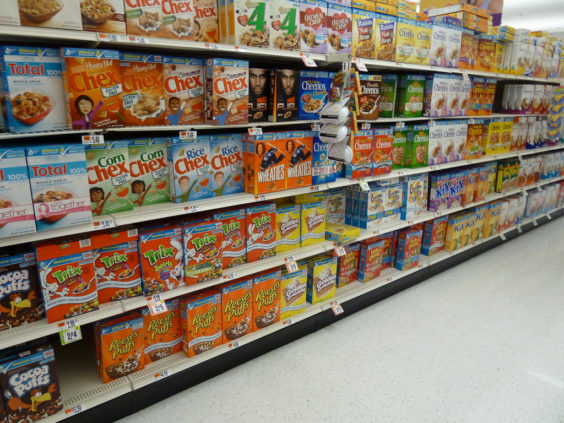
Need a tube of toothpaste? If you make a grocery store run, you’ll be faced with shelves full of as many as 54 varieties of Crest alone. America’s best-selling brand of coffee, Folgers, has 84 different flavors and sizes available. And Tide? The venerable brand offers a grand total of 158 different sizes, varieties and scents of detergent – and that’s not even counting stain removers and other related products carrying the Tide name.
It’s a wonder any of us can get through the grocery store at all, without being paralyzed with indecision.
“Option overload” is the subject of a recent Consumer Reports survey, which found that nearly 80% of those questioned noticed “an especially wide range of choices” in their local grocery store. 36% of those said they were “overwhelmed by the information they had to process to make a buying decision.” And 5% really were paralyzed with indecision – they reported being so overwhelmed by options, they’ve simply walked away at times, without buying anything at all.
“My wife went to a new Walmart Super Center for toothpaste,” one commenter wrote in response to Consumer Reports’ request for input on its Facebook page. “Suddenly faced with a wall of toothpaste in hundreds of brands, flavors, claims and sizes, she almost sat down in the aisle to cry. It was so overwhelming.”
Other commenters resented having to spend time scrutinizing labels and price-per-ounce shelf tags, in order to get the best deal. And one even suggested a coupon-related conspiracy: “Manufacturers love the confusion, because so many people arrive at the checkout counter unable to apply their coupons, because the size, flavor, or variety is not the one discounted.”
Psychologist Barry Schwartz described this phenomenon in his 2004 book “The Paradox of Choice: Why More Is Less.” “When people have no choice, life is almost unbearable,” he wrote. So having some choice is good, he argued. But as options begin increasing exponentially, “choice no longer liberates, but debilitates.”
So why don’t stores put a stop to this? It turns out that some have tried – to disastrous results.
The typical grocery store carries more than 42,000 different products. The typical Walmart carries around 150,000. Even Walmart decided things were getting a little out of control several years ago, so it decided to launch a “rationalization” project, eliminating thousands of products in an effort to reduce the clutter associated with too many choices.
And the effort flopped. Customers howled in protest when their favorite products were pulled from the shelves. So in 2011, Walmart reversed course, and brought thousands of products back. “We’ve listened to our customers and we’re bringing back the products and brands they want,” said Walmart’s chief merchandising officer Duncan Mac Naughton.
A recent study from Catalina Marketing found that the average supermarket shopper buys just 260 different items a year, and ignores the rest. But just because you may only buy one kind of Tide, doesn’t mean there aren’t devotees to the other 157 varieties. If a store “rationalizes” its selection too much, it risks losing customers who will look for their favorite discontinued product somewhere else.
On the flip side, some stores have lost customers by continuing to offer too many choices. “This is why I shop at Aldi. Quick and easy,” one commenter wrote in response to Consumer Reports’ Facebook query. “Shop at Costco and you don’t have to worry about a huge selection, they don’t have one,” added another.
And then there are those who actually enjoy having entire aisles full of cereal, soft drinks or soaps to choose from. “I love to go to grocery stores and find new products that I haven’t tried,” one Consumer Reports Facebook commenter wrote. “It’s a big world out there and so fun to discover.”
That shopper will be happy to know, then, that Crest has just added three new varieties of toothpaste to its ever-expanding product lineup. At the rate that companies keep adding new products, you could probably pick a different type of toothpaste, coffee and laundry detergent every time you shop, and go an entire lifetime without ever buying the exact same thing twice.
Now that’s selection.











“If a store “rationalizes” its selection”
What? What the heck? Who needs to rationalize when you have UPC codes?
Those blasted things were 1st introduced as a TOOL to control inventory.
No ‘rationalization’ required. Yank the items that are just sitting there eating up shelf space.
You know what I mean-those items that have been sitting there so long they’re practically ancient artifacts. Get rid of them-and don’t order it again. Period.
Oh, I totally agree w/ the premise of the article-I feel the same way. Sometimes I get so cynical-that I feel like it’s a trick. A dirty trick they’re playing on us. Say you get a coupon for toothpaste. name brand toothpaste .50off 1 package.
Sounds simple-right?
Nope.
You have to buy the one in the blue box. Dark blue-not light blue.
The coupon is for the one that is exactly 16.75 ounces. Nope, not that 17 oz package.
Oh and it’s for the striped paste-not plain paste, or gel. No not those.
And it has to be the breath freshening one-not teeth whitening one….
…and the coupon expires in 5 days.
Okay, Coupon in hand, you go to the big box store, this brand has a display of products that spans 20 square feet.
And this particular product that you have a coupon for?
Store doesn’t carry it.